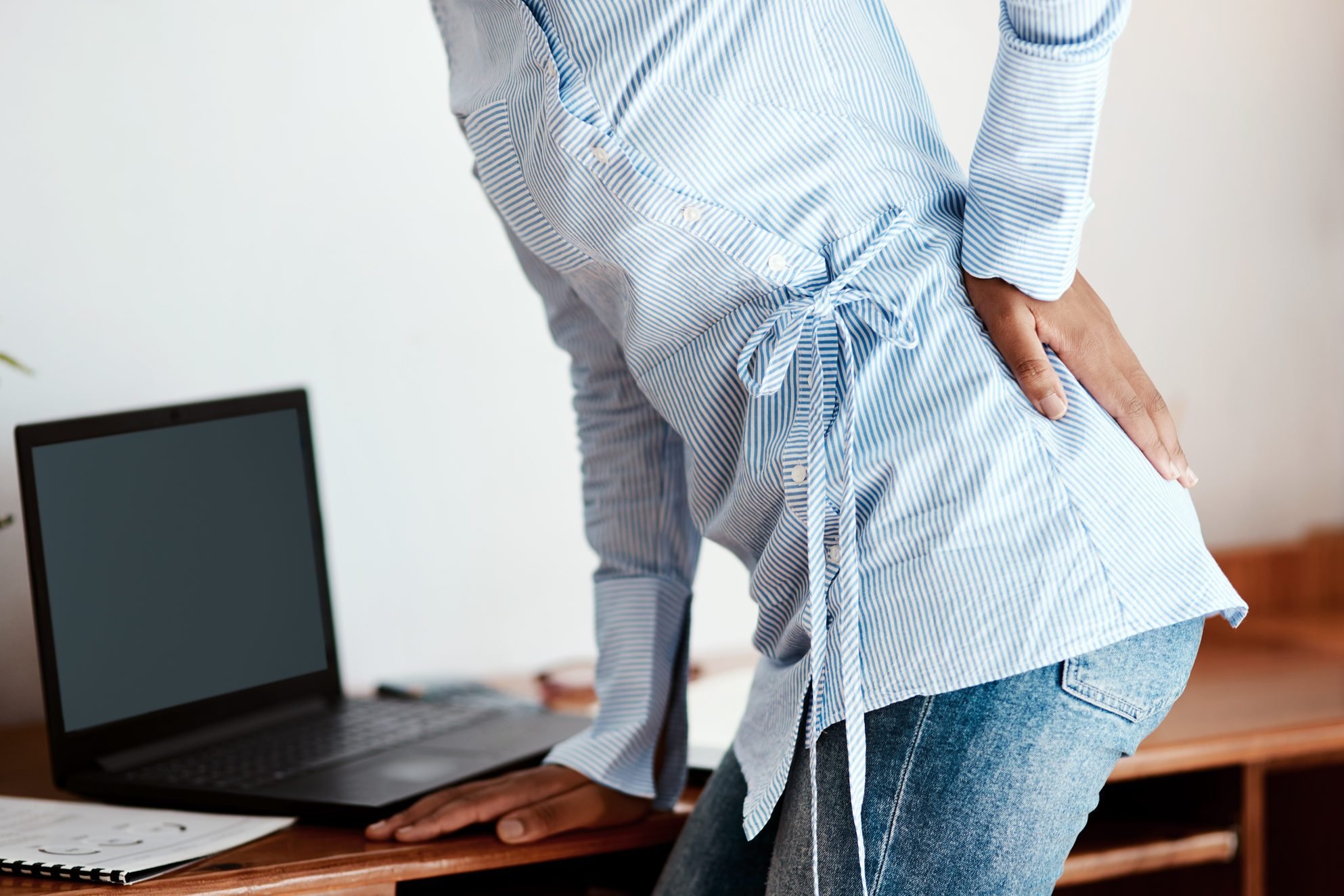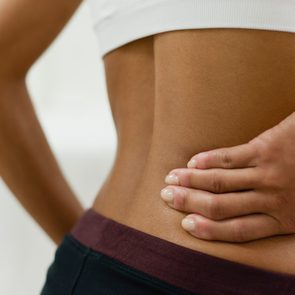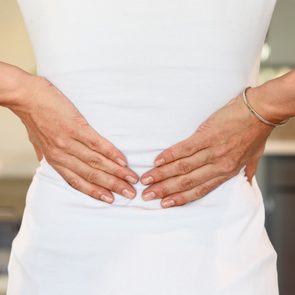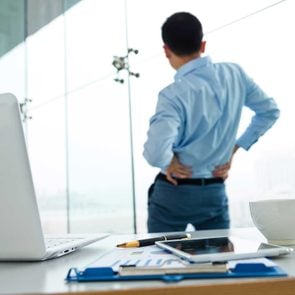8 Causes of Lower Back Pain on Your Left or Right Side
Updated: May 13, 2021
One of these conditions may be behind the lower back pain on your right side or left side. Here's what to know about one-sided back pain.
Understanding lower back pain
If your back hurts, you’re not alone. Lower back pain is one of the most common musculoskeletal problems—conditions that affect muscles, bones, tendons, ligaments, and nerves—in the world.
A study published in 2020 in the Annals of Translational Medicine found that lower back pain was the leading cause of years spent with a disability and missed work. Additional research, published in the International Journal of Environmental Research and Public Health in 2020, reveals that Covid-19 quarantines have exacerbated the issue of lower back pain even more.
Learn more about what it means if you specifically have pain on the left or right side, common causes of these aches, and when to call your doctor for help.
Types of lower back pain
When considering your lower back pain, think about whether you feel it across your lower back like a band, or whether you feel the pain more intensely on one side versus the other, says Gharibo. If it’s band-like, it’s more likely to relate to a disc in your spinal cord.
Having more pain on the left or right side typically signals a muscle sprain or strain, or an issue with a one-sided structure like the hip joint or sacroiliac joint (which connects your pelvis and low spine), Dr. Gharibo explains. However, these issues can affect all areas of the back, from the middle to the sides, so it’s there’s no easy diagnosis.
Lower back pain can be acute, lasting a few days to a few weeks, or chronic, which means it lasts longer than 12 weeks, according to the National Institute of Neurological Disorders and Stroke.
“Inflammation causes low back pain, and it tends to be intermittent at first,” Dr. Gharibo explains. For example, you might feel your lower back ache in the mornings initially, and then it becomes more significant and sometimes seasonal, showing up more often during cold or damp weather. Eventually, this pain can become consistent. You want to address the pain before it becomes consistent.

Causes of lower back pain on the left or right side
Muscle sprain or strain
This is the most common cause of pain, particularly of the right or left side of your lower back, says Dr. Gharibo. It often pops up because of poor posture, body mechanics, and deconditioning (fitness loss that happens when you stop working out; it can make the muscles of the low back more prone to acute sprains or strains).
Lifting something incorrectly or attempting to lift too much weight can lead to lower back pain, Dr. Gharibo says. You might feel a spasm when this happens, like your muscle is contracting quickly and painfully.
If you experienced an event that led to a strain or spasm, the obvious next step is to avoid repeating that same activity. Lying down for a short period of time will take the pressure off of your spine, which may help relieve some of the discomfort, according to Dr. Gharibo.
If you don’t have conditions that stop you from taking certain medications, Dr. Gharibo suggests taking an over-the-counter pain reliever, too. He recommends acetaminophen (like Tylenol) and ibuprofen (such as Motrin) taken together to help aid the aches. If one pill doesn’t work, two may better control the issue, he says. (Make sure to talk to your doctor before taking any medications.)
Poor posture
Aging and poor posture are two top reasons people experience chronic lower back pain. “We can’t do much about aging, but there’s a lot we can do about the core and body mechanics [involved in your posture],” Dr. Gharibo says. “This is especially important with Covid. As more people are at home, there’s a lot of deconditioning, weight gain, and lack of exercise.”
Returning to activity can pose issues as well, he says. If your core and back are weak and you don’t ease back into exercise with good technique, you can develop pain.
A few simple steps will help you mitigate posture problems. For starters, check your seated position, Dr. Gharibo says. Pull your belly in, engaging the abs, and line your shoulders up on top of your hips (avoid leaning to one side, or too far forward or backward). And create height to take the pressure off the low back by sitting up nice and tall.
What will also help: Avoid lifting heavy weights with your back and, instead, use your legs. Incorporate core training into your exercise routine, too, so you strengthen and stabilize your midsection to help you maintain good posture throughout all daily activities.
Weak core muscles
Speaking of your core, if it’s not doing its job to protect the spine, you will likely feel some lower back pain. Core muscles run along the spine, on each side, and they support us in staying upright. “They provide great structural support to the lumbar [or low] spine, and the upper parts too,” says Dr. Gharibo.
If you have a weak core and go about the day flexing, extending, and rotating the spine, over time you may experience disc degeneration. This degeneration can then lead to issues like spinal stenosis (a narrowing of the spinal canal), lumbar facet syndrome (irritation at the back of the low spine), osteoarthritis (degeneration of cartilage and bone), or lumbosacral radiculopathy (pain along the sciatic nerve, usually from a herniated disc putting pressure on nerves).
“Having a strong core is a big part of the equation, but you also have to use the core and proper body mechanics as you go about your day, sitting, standing, and lifting,” Dr. Gharibo says. “A good core and proper body mechanics will help to mitigate forms of aging. And as we take care of our core, we’ll have less back pain.”
Herniated disc
Discs act like pillows and shock absorbers between the vertebrae (bones of the spine). When you have a herniated disc, a part of its nucleus, the softer, gel-like interior, gets pushed out of the disc’s tough outer layer and into the spinal canal.
There, it can press on spinal nerves, leading to pain. Herniated discs can occur anywhere on the spine, but commonly happen at the L4-L5 or L5-S1 sections, located in the low back. This can lead to pain in the back, butt, and leg, says Dr. Gharibo.
Sometimes a herniated disc can push on the sciatic nerve, which runs down the back, leg, and butt and can cause pain on one side. This often comes with burning sensations and numbness, too.
To help alleviate the aches associated with herniated discs, Dr. Gharibo suggests the over-the-counter combo of an acetaminophen and ibuprofen pill, two if the pain persists.
“As we help the spine and the joints stay healthy, we minimize the risk of herniated discs, too,” he adds.
Myofascial issues
On the back of the spine, there are paraspinal muscles that support the back. They can sometimes hurt thanks to myofascial pain, an ache and inflammation of the fascia (connective tissue that hold the muscles together). You might also experience this in the piriformis muscle of the buttocks, Dr. Gharibo says, which can feel like lower right or lower left back pain.
Myofascial issues tend to resolve on their own, after a couple of days or a week. But the best way to address the problem is with a massage and/or stretching. “The area that’s in pain should be stretched in all directions, but not to its limit,” Gharibo says. “Go for 80 percent of your range of motion.” (To start, try these piriformis stretches.)
Scheduling an appointment with a physical therapist can help you learn to address these aches. A therapist can show you specific exercises to help relieve discomfort.
Gentle heat from a low-setting heating pad or a warm shower could also provide some relief, Gharibo says.
Kidney stones
Your back pain on the left or right side might also come from kidney stones, or a solid piece of material that can form in one or both kidneys, Dr. Danesh says. However, this pain will be located a little higher up the back, under the ribs. “The bigger the stone, the more intense the pain,” Dr. Danesh adds.
Kidney stones form from high level of minerals in your urine. Sometimes you can pass a smaller stone through your urinary tract, and other times you’ll need your doctor to remove it or break it up into smaller pieces so you can pass it.
If you’ve had or regularly get kidney stones, your doctor may prescribe medication to prevent them in the future. A key way to prevent kidney stones is by drinking plenty of water—six to eight 8-ounce glasses a day.
Uterine issues
The uterus—aka the womb—is a reproductive organ that plays a starring role in a woman’s period and holds a fetus during pregnancy. Uterine issues, like endometriosis or uterine fibroids, can also lead to pain in your back.
Endometriosis occurs when tissues similar to the lining of the uterus grow outside of the uterus and on other organs in the pelvis or body, like the ovaries or fallopian tubes. Researchers are still digging into the cause of the condition (which you can’t prevent) as well as its treatment, but sometimes hormonal birth control or surgery will help. (Here are 12 things you may not know about endometriosis.)
Uterine fibroids, on the other hand, are muscular tumors—almost always noncancerous—that grow on or in the wall of uterus. Some women with fibroids won’t have any symptoms, while others will experience pain or heavy bleeding. Researchers aren’t sure what causes fibroids either, but doctors often recommend over-the-counter pain meds. If your case is very severe, your doctor may recommend one of several types of surgery to remove them.
Organ-related pain (like that caused by uterine issues) is often imprecise, so while the organs may not be at your lower back, the pain can register as back pain, says Houman Danesh, MD, director of integrative pain management at Mount Sinai Hospital in New York City. “The lining of the organ gets irritated, which leads to a vague pain that the body doesn’t know how to interpret, so it registers as back pain,” he explains.
Uterine pain, whether from endometriosis or uterine fibroids, typically presents as a dull, ache. Your doctor will take a full exam and likely imaging to confirm these uterine issues, says Dr. Danesh.
Ovarian cyst
Most woman have two ovaries, one on either side of the uterus. They release eggs during a monthly menstrual cycle in people of reproductive age. Cysts can form on the ovaries and are common in women who still get their periods, less so in postmenopausal women.
An ovarian cyst is a fluid-filled sac that forms on the ovaries, often during ovulation. Most are noncancerous and harmless—they often appear without symptoms.
Ruptured cysts, however, can cause severe pain. Like uterine issues, your body might register an ovarian cyst as back pain, Dr. Danesh says. Signs to watch for: a dull ache in the low back and/or unusual vaginal bleeding.
After an exam, imaging, and/or blood tests, your doctor should have a diagnosis. Your doctor may prescribe hormonal birth control to halt ovulation and lower the risk of more cysts forming and/or suggest an over-the-counter pain medication to help control the aches.
When to see a doctor
One of the standout signs it’s time to see a doctor about lower back pain is it’s getting worse, not better, says Dr. Gharibo. If the pain interferes with your quality of life and activities of daily living, make an appointment to see a professional.
A few other signs it’s time to call your health care provider: numbness or weakness in the legs, bowel or bladder issues, and a loss of control of the bowels or bladder. If you can’t get in touch with your personal doctor but still experience these symptoms, Dr. Gharibo suggests going to the emergency room.
If new pains start to develop on top of your lower back pain, that’s another sign it’s time to seek more immediate medical attention. “The concern is the severe progression of a herniated disc, compression of nerves, and neurological deficits,” he says.
It’s important to talk to your doctor if pain persists, in case you have a more-serious condition that needs treatment beyond musculoskeletal work. This might include an abdominal aneurysm, kidney cancer, pancreatic cancer, pancreatic inflammation, or kidney stones, Dr. Gharibo says.
These serious but relatively rare issues might result in lower right or lower left back pain, so it’s important to get checked out.
“Most of the time, these don’t cause severe pain at the onset but can cause progressive pain,” he explains. “These are rare, but it’s important not to miss them, so talk to your doctor about your pain.”
Next, check out the best sleeping position for lower back pain.























